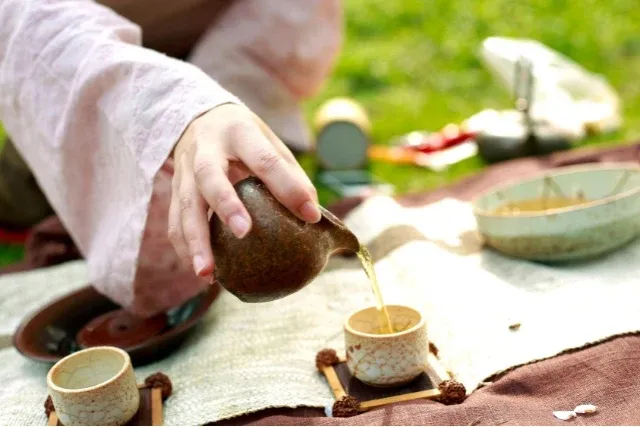The Timeless Joy of Tea Time: A Cross-Cultural Celebration of Reflection and Connection...!!!
Tea time is a beloved tradition that transcends cultures and generations. It is a moment to pause, reflect, and connect with others while enjoying the simple pleasure of a well-brewed cup of tea.

Tea time is more than just an opportunity to enjoy a hot beverage; it is a cherished tradition spanning cultures and generations. This ritual, deeply rooted in history, brings people together, offering a pause from the hustle and bustle of daily life.
The tradition of tea drinking dates back to ancient China, where it was discovered over 4,000 years ago. According to legend, Emperor Shen Nong accidentally discovered tea when leaves from a wild tea tree blew into his pot of boiling water. The resulting infusion was found to be refreshing and invigorating, leading to the widespread cultivation and consumption of tea.
Tea made its way to Europe in the 16th century, thanks to Portuguese and Dutch traders. By the 17th century, it had become a popular beverage in England. The concept of "afternoon tea" is attributed to Anna, the Duchess of Bedford, in the early 19th century. She introduced the practice of having a light meal with tea in the afternoon to curb hunger between lunch and dinner. This tradition quickly gained popularity and became a social event among the British aristocracy.

Variations of Tea Time Across Cultures
Tea time takes on different forms and significance across various cultures. Here are a few notable examples:
-
British Afternoon Tea:
-
Tradition: British afternoon tea typically includes a selection of finger sandwiches, scones with clotted cream and jam, and an assortment of pastries and cakes.
-
Setting: Often enjoyed in elegant tearooms, hotels, or at home, this ritual is accompanied by loose-leaf tea served in fine china.
-
Social Aspect: Afternoon tea is a time for socializing, catching up with friends, and enjoying a leisurely break.
-
-
Chinese Tea Ceremony:
-
Tradition: The Chinese tea ceremony, known as "Gongfu Cha," is a highly ritualized and meditative practice. It involves the careful preparation and presentation of tea, focusing on the quality of the tea leaves and the art of brewing.
-
Setting: Conducted in a serene and tranquil environment, the ceremony emphasizes mindfulness and respect for nature.
-
Social Aspect: It is a time for quiet reflection, bonding with family and friends, and appreciating the subtleties of tea.
-
-
Japanese Tea Ceremony:
-
Tradition: The Japanese tea ceremony, known as "Chanoyu" or "Sado," is a refined and spiritual practice. It involves the preparation and serving of matcha, a powdered green tea, following specific rituals and etiquette.
-
Setting: The ceremony is conducted in a tearoom, often in a traditional Japanese garden, to create a harmonious atmosphere.
-
Social Aspect: It is a moment of tranquility, mutual respect, and mindfulness, fostering a sense of connection and gratitude.
-
-
Moroccan Tea Time:
-
Tradition: In Morocco, tea time revolves around the preparation and serving of mint tea, known as "Atay." The tea is brewed with green tea leaves, fresh mint, and a generous amount of sugar.
-
Setting: Served in ornate tea glasses from a beautifully crafted teapot, the tea is poured from a height to create a frothy top.
-
Social Aspect: Moroccan tea time is a symbol of hospitality and is often shared with guests as a sign of friendship and warmth.
-
The Joy of Tea Time
Tea time offers numerous benefits beyond the pleasure of drinking tea. It provides a moment of relaxation, allowing individuals to unwind and de-stress. The act of brewing and sipping tea can be meditative, promoting mindfulness and a sense of well-being.
Socially, tea time fosters connections and strengthens relationships. Whether it is a formal afternoon tea, a casual gathering with friends, or a quiet moment alone, tea time creates an opportunity for meaningful conversations and bonding.
The variety of teas available also adds to the joy of tea time. From the delicate flavors of white tea to the robust taste of black tea, there is a tea to suit every palate. Herbal teas, such as chamomile and peppermint, offer soothing and health-promoting properties, while green tea is celebrated for its antioxidants and numerous health benefits.
Tea time is a beloved tradition that transcends cultures and generations. It is a moment to pause, reflect, and connect with others while enjoying the simple pleasure of a well-brewed cup of tea. Whether you are partaking in a British afternoon tea, a Chinese tea ceremony, a Japanese matcha ritual, or a Moroccan mint tea gathering, the essence of tea time remains the same: a celebration of the senses, a respite from daily life, and a time to savor the present moment. So, brew yourself a cup of tea, take a deep breath, and embrace the timeless joy of tea time.
What's Your Reaction?

















